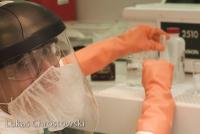Process Name:
GLASSETCH
Author:
Mark Bachman, Summer 2000; ANF adapted, M. Beaudoin, 2014.
Overview:
Time Needed:
Approximately 1 hour for 60 μm etch.
Materials Needed:
- Buffered HF (5 ml)
- Hydrochloric acid (9.25 ml)
- Water (85 ml)
- Plastic beaker
- Neoprene gloves
- Hot plate with stirring rod, if buffered HF unavailable
- Ammonium fluoride (NH4F) crystals (40 g), if buffered HF unavailable
- Hydrogen fluoride, 49%, (10 ml), if buffered HD is unavailable
Preparation:
The buffered HF mixture is a dangerous chemical and protective gear must be worn when using it, in particular, apron, acid (orange) gloves and faceshield protection must be worn. Don protective gear and work only in the wetbench.
If a buffered HF mixture is not available, you can prepare a fresh mixture in the following manner. Measure 60 ml of of NH4F solution in a teflon or plastic beaker. Carefully add 10 ml of 49% hydrofluoric acid (HF) to the solution. Label the container “Buffered HF etchant—extremely dangerous!”, then add your name, the date, and a target organs sticker (if there are no stickers, copy the information from the HF bottle on the new container).
To create your glass etching solution, put 85 ml DI water in a polypropylene or Teflon container. Add 5 ml of buffered HF to the water. Add 9-10 ml of HCl to the solution. Stir with a plastic stirrer.
Procedure:
Make sure the glass to etch has a hard resist mask patterned on it such that desired etch regions are exposed, and that the backside is protected. Many researchers pattern a metal mask on the glass before etching, but an extra hard bake of resist can sometimes be used effectively. For a photoresist mask, a hard bake (130 °C for 45 min) is recommended to make sure the resist firmly adheres to the glass.
Don neoprene or thick nitrile gloves. Do not breathe HF vapors. Put the glass substrate in the etchant and stir vigorously. The glass will etch at approximately 1 μm/min at room temperature. Rinse in DI water. When finished with the etchant, dispose in a waste bottle labeled “HF Waste”. To remove the photoresist, use warm acetone or an appropriate resist stripper. Ultrasonic bath may be necessary to remove stubborn resist residues. Rinse with DI water, then blow dry.
Cleanup:
Clean up all materials. Dispose etchant in a labeled waste bottle that is normally stored under the wetbench in the HF and compatibles secondary box.
Safety & Emergency:
All ANF safety and procedural regulations must be followed. Hydrofluoric acid (HF) is an extemely toxic and dangerous acid. Use of HF requires at least one other person in the clean room (buddy system). HF should be handled in a laminar flow bench, using nitrile gloves inside the acid gloves, apron, and full facial (eye) protection. Any small spills should be wiped up immediately with wipes and rinsed. Rinse the wipes with abundant DI water in the sink. When properly rinsed, dispose of rinsed wipes in the waste container. NEVER LEAVE the etchant unattended.
In case of exposure to HF Seek medical attention immediately! For skin exposure, flush immediately with water for 5 minutes followed by liberal application of calcium gluconate gel to the skin. Remove all clothing that are exposed before and while flushing with water. For eye exposure, flush the eyes with water three times, 5 minutes each. Irrigate the eye repeatedly with 500-1000 ml of a 1% calcium gluconate solution applied through a syringe. Call for prompt emergency room transport. Apply ice-water compresses during transport. In case of large spill, EVACUATE THE CLEANROOMS IMMEDIATELY and activate the evacuation alarm.
References:
- Marten Stjernstrom and Johan Roeraade, “Method for fabrication of microfluidic systems in glass”, J. Micromech. Microeng. 8 (1998) 33-38.
